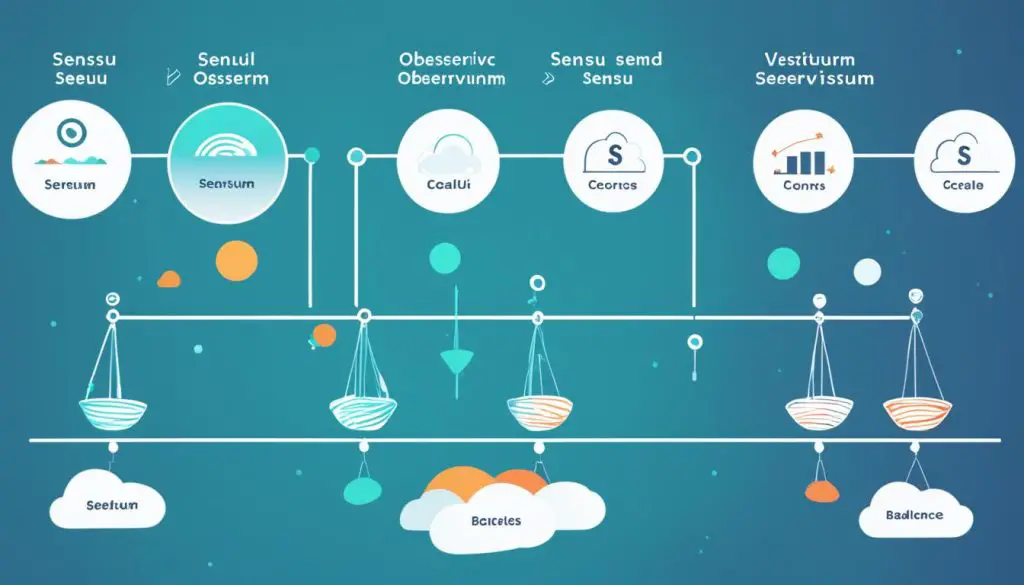Sensu vs. Observium: A Detailed Monitoring Comparison
Are you struggling to find the perfect network monitoring tool for your organization? Look no further. In this in-depth comparison, I will unravel the differences between two leading contenders: Sensu and Observium. These powerful tools offer a wide array of features and functionalities that can significantly enhance your network monitoring capabilities. Are you ready to discover which tool will best suit your monitoring needs?
Key Takeaways:
- Sensu and Observium are both powerful network monitoring tools with distinct features and deployment options.
- Observium is a free and open-source tool, making it cost-effective for small to medium-sized businesses.
- Sensu offers a flexible pricing model, making it suitable for larger enterprises.
- Observium specializes in network and server hardware health checks, with comprehensive analytics and support for a wide range of devices.
- Sensu focuses on flexible monitoring workflows and adaptability to dynamic infrastructure.
Pricing and Deployment
When it comes to choosing a network monitoring tool, two popular options are Sensu and Observium. In this section, we will explore the pricing and deployment options offered by both tools to help you make an informed decision.
Pricing
Observium stands out as a cost-effective choice for small to medium-sized businesses. It is a free and open-source tool, allowing organizations to monitor their networks without incurring additional expenses. This affordability makes it an appealing solution for those with budget constraints.
Sensu, on the other hand, offers a flexible pricing model that caters to the needs of larger enterprises. It charges based on the number of users and nodes being monitored, allowing organizations to scale their monitoring operations according to their requirements. This pricing model ensures that enterprises pay only for the resources they utilize, making it a suitable choice for businesses with extensive monitoring needs.
Deployment
Both Sensu and Observium provide versatile deployment options, enabling users to choose the setup that best suits their infrastructure requirements.
Observium can be deployed on-premises or in the cloud, giving organizations the flexibility to choose the environment that aligns with their existing infrastructure setup. Whether you prefer an on-site deployment for enhanced control or a cloud-based deployment for scalability and ease of management, Observium can accommodate your needs.
Sensu offers similar flexibility when it comes to deployment options. It can be installed on-premises or hosted in the cloud, allowing organizations to select the deployment method that aligns with their infrastructure and security policies. This adaptability ensures that Sensu can seamlessly integrate into your existing environment, fostering a smooth monitoring experience.
Overall, both Sensu and Observium offer pricing and deployment options that cater to different organizational needs. Whether you prioritize affordability or require scalability and flexibility in deployment, these tools have you covered.
Features and Functionality
When comparing Sensu and Observium, it’s important to understand their unique features and functionality. Observium specializes in network and server hardware health checks, providing detailed analytics on network traffic, application performance, and user behavior. With its wide range of network hardware and operating system support, Observium offers a comprehensive solution for monitoring and managing your network infrastructure.
On the other hand, Sensu focuses on flexible monitoring workflows, allowing users to define custom monitoring pipelines and adapt to dynamic infrastructure. This gives organizations the ability to tailor their monitoring approach to their specific needs. Sensu also offers a variety of plugins and integrations to extend its functionality and integrate with existing tools and systems.
Whether you prioritize in-depth analytics and hardware health checks or need the flexibility to customize your monitoring workflows, both Sensu and Observium offer powerful features and functionality to meet your network monitoring needs.
Analytics and Health Checks
Observium’s robust analytics capabilities provide valuable insights into network traffic, application performance, and user behavior. These detailed analytics allow you to proactively identify and troubleshoot issues, ensuring optimal network performance. Additionally, Observium’s support for a wide range of network hardware and operating systems means you can monitor your entire network infrastructure from a single platform.
Flexible Monitoring Workflows
Sensu’s emphasis on flexible monitoring workflows empowers users to create custom monitoring pipelines that align with the dynamic nature of their infrastructure. This flexibility enables organizations to automate monitoring processes, respond to changes in real-time, and ensure proactive troubleshooting. Sensu’s extensive plugin ecosystem further enhances its functionality, offering a wide range of options to extend its capabilities and integrate with other systems.
“Observium’s detailed analytics provide valuable insights into network traffic, application performance, and user behavior, while Sensu’s focus on flexible monitoring workflows allows for custom monitoring pipelines and adaptability to dynamic infrastructure.”
Both Sensu and Observium offer powerful features and functionality that can enhance your network monitoring capabilities. Evaluating which tool’s approach aligns best with your organization’s needs and priorities will help you make an informed decision.
Performance and Scalability
When it comes to network monitoring tools, performance and scalability are crucial factors to consider. Both Observium and Sensu offer impressive capabilities in these areas, ensuring that your monitoring needs are met efficiently and effectively.
Observium’s lightweight and efficient core allows it to handle millions of metrics from thousands of devices without significant performance impact. This means that you can rely on Observium to deliver accurate and real-time performance data, even in large-scale environments. Additionally, Observium offers distributed monitoring, enabling you to track performance across multiple locations seamlessly. This feature is particularly valuable for organizations with distributed infrastructure.
On the other hand, Sensu’s architecture is designed to be scalable, allowing it to adapt to the growing monitoring needs of your organization. With Sensu Go, its runtime environment, deployment becomes hassle-free, enabling you to set up monitoring quickly and efficiently. This scalability ensures that Sensu can handle the increasing demands of your infrastructure as it grows.
Whether you choose Observium or Sensu, you can rest assured that both tools are equipped to handle the performance and scalability requirements of modern networks. Now, let’s explore the user interface and ease of use of these two monitoring tools.
User Interface and Ease of Use
When it comes to monitoring your network, having a user-friendly interface and an easy-to-use tool is crucial. In this section, we will explore the user interface and ease of use of both Sensu and Observium, two popular network monitoring tools.
Observium’s Navigable Interface
Observium is designed with simplicity in mind. Its interface provides a seamless experience for monitoring the health and performance of your network. With an intuitive setup, users can quickly get started and navigate through the tool effortlessly.
Once you’re inside Observium, you’ll find a clean and organized dashboard that presents performance statistics in a visually appealing manner. The interface allows you to track network traffic, analyze application performance, and monitor user behavior, all with ease.
Observium’s user interface focuses on providing clear and concise information, making it easy for users to assess the status of their network at a glance. Whether you’re a beginner or an experienced user, Observium’s interface ensures a smooth monitoring experience.
Sensu’s Customizable Workflows and Community Support
Sensu may have a slightly steeper learning curve for newcomers, but its power lies in its customizable workflows and extensive community support. While navigating through Sensu, you’ll discover the ability to define and tailor monitoring workflows to suit your specific needs.
With Sensu, you can take advantage of its flexibility to adapt to your dynamic infrastructure. The tool’s interface provides you with the freedom to create custom monitoring pipelines, allowing you to monitor and manage your network with precision.
Although Sensu may require a bit more time to get acquainted with its advanced features, the extensive community support available can help ease the learning process. Sensu’s community is filled with experienced users who freely share their knowledge, making it easier for new users to get the most out of the tool.
Both Sensu and Observium prioritize user interface and ease of use. Observium offers a navigable interface that presents performance statistics in an intuitive way, making it easy for users to monitor their networks. Sensu, while having a steeper learning curve, offers customizable workflows and extensive community support, catering to the needs of experienced users.
Now that we have explored the user interface and ease of use for both tools, let’s dive deeper into the support and community surrounding Sensu and Observium in the next section.
Support and Community
When it comes to selecting a network monitoring tool like Sensu or Observium, the availability of support and an active community can greatly enhance your experience. Both Sensu and Observium offer robust support systems and vibrant communities that ensure users have access to the resources and assistance they need.
Observium has a dedicated community of users who actively contribute to its development and provide support through forums and documentation. This active community ensures that Observium stays up-to-date, receives continuous improvements, and addresses any issues that may arise. Whether you need help troubleshooting a problem or want to share your experiences, Observium’s community is there to assist you.
Sensu, too, has a strong community backing that is committed to driving continuous improvements and updates. This community, comprising both users and developers, contributes to the ongoing development of Sensu and enriches the user experience. Whether you are searching for implementation tips, exploring best practices, or seeking answers to specific questions, Sensu’s community is a valuable resource.
Both Sensu and Observium also provide extensive documentation and resources to aid users in troubleshooting and implementation. These documentation libraries serve as comprehensive references, offering instructions and insights into various features and functionalities of the tools. Whether you are a beginner or an advanced user, these resources will guide you through the process of harnessing the full potential of Sensu or Observium.
In conclusion, Sensu and Observium provide excellent support and have passionate communities that actively contribute to the tools’ development. It is comforting to know that there is a supportive and knowledgeable community ready to assist you should you encounter any challenges or simply seek advice. With comprehensive documentation and resources at your disposal, you can confidently navigate and maximize the capabilities of Sensu and Observium.
Pros and Cons
When comparing Sensu and Observium, it’s important to consider their respective pros and cons. Both tools offer unique features and benefits that cater to different monitoring needs.
Observium
Observium has several advantages that make it a compelling choice for network monitoring. First and foremost, it is an open-source solution, allowing businesses to leverage its capabilities without significant financial investment. Additionally, Observium boasts comprehensive network hardware support, ensuring compatibility with a wide range of devices. Its easy-to-use interface makes it accessible to users of all levels of technical expertise, simplifying the monitoring process.
Observium’s open-source nature, comprehensive network hardware support, and easy-to-use interface make it a strong contender in the network monitoring space.
However, Observium does have a few limitations. It may have limited customization options, which can be a drawback for businesses with specific monitoring requirements. Additionally, while its lightweight nature makes it suitable for larger networks, it may have overhead for smaller networks where resource optimization is crucial.
Sensu
Sensu brings its own set of pros to the table. The tool’s flexibility allows users to adapt it to dynamic infrastructure, making it an excellent choice for organizations with rapidly changing monitoring needs. Its extensive plugin ecosystem provides additional functionality, enabling users to customize their monitoring workflows. These features make Sensu ideal for users who require a high degree of flexibility and customization in their monitoring setup.
Sensu’s flexibility, adaptability to dynamic infrastructure, and extensive plugin ecosystem make it an attractive option for users seeking customizable monitoring workflows.
However, Sensu’s strengths may come with a trade-off. Its flexibility and advanced features may lead to a steeper learning curve for new users who are not familiar with its setup and configuration. This learning curve can prolong the initial implementation phase and require additional support and training for effective utilization.
Considering the pros and cons of both Sensu and Observium is crucial for making an informed decision regarding which tool aligns best with your organization’s monitoring requirements.

Continue reading to explore alternatives to Sensu and Observium in the next section.
Alternatives
While Observium and Sensu are powerful monitoring tools, it’s important to consider alternative options in the market. These alternatives provide unique strengths and features that may better align with specific monitoring requirements. Here are some popular alternatives to consider:
PRTG
PRTG is a comprehensive network monitoring tool that offers a wide range of monitoring capabilities. It provides real-time insights into network performance, alerts, and notifications. With its intuitive interface and customizable dashboards, PRTG is a popular choice for businesses of all sizes.
Site24x7
Site24x7 is a cloud-based monitoring tool that offers a holistic view of your network infrastructure. It provides real-time monitoring of servers, applications, websites, and more. With its extensive monitoring capabilities and user-friendly interface, Site24x7 is a reliable alternative to consider.
Datadog
Datadog is a unified monitoring platform that allows you to monitor your entire infrastructure, including networks, servers, applications, and cloud services. It provides real-time visibility into system performance and offers advanced analytics and visualization features. Datadog is widely used by businesses looking for a comprehensive and scalable monitoring solution.
Nagios XI
Nagios XI is an enterprise-grade monitoring tool that enables you to monitor the health and performance of your network infrastructure. It offers a wide range of monitoring capabilities, including network devices, services, applications, and system metrics. Nagios XI’s flexible and customizable nature makes it a popular choice for larger organizations.
Remember, when considering alternatives to Observium and Sensu, it’s crucial to evaluate their features, pricing, scalability, and user reviews to ensure they align with your specific monitoring needs.
Exploring these alternative options will help you make an informed decision and find the monitoring tool that best suits your organization’s requirements.
Company Details
When considering network monitoring tools like Sensu and Observium, it is important to understand the companies behind them. Observium is developed and maintained by a community of contributors, with its source code available on GitHub. This open-source nature allows for collaboration and continuous improvement from a diverse group of contributors.
Sensu, on the other hand, is backed by Sensu Inc., a company that focuses on providing monitoring solutions and support to enterprises. Sensu Inc. brings a wealth of expertise and resources to the table, ensuring that users have access to reliable support and regular updates to the tool.
Both Sensu and Observium have their advantages, but understanding the background and support behind each tool can have an impact on the decision-making process. Observium’s open-source community offers the potential for customization and community-driven development, while Sensu Inc.’s backing ensures stability, support, and a roadmap for future enhancements.
Performance Insights and Reviews
When it comes to evaluating network monitoring tools like Sensu and Observium, performance and functionality are key factors that users consider. Both Sensu and Observium have garnered positive reviews for their capabilities and performance, making them popular choices among monitoring professionals.
Observium has received acclaim for its user-friendly interface, which allows for easy navigation and monitoring of network health. Users appreciate its intuitive design and the comprehensive analytics it provides. With Observium, you can gain detailed insights into network traffic, application performance, and user behavior. Additionally, Observium offers extensive support for a wide range of network hardware and operating systems, further enhancing its versatility and usefulness for network monitoring tasks.
Sensu, on the other hand, has earned praise for its flexiility and adaptability. Users looking for custom monitoring workflows and the ability to adapt to dynamic infrastructure have found Sensu to be a powerful tool. Its plugin ecosystem enables users to extend the functionality and customize their monitoring pipelines, meeting their specific requirements effectively.
“Sensu allows me to create custom monitoring workflows that perfectly align with my organization’s needs. Its flexibility and adaptability make it a perfect fit for our dynamic infrastructure.” – A satisfied Sensu user.
By exploring user reviews and performance insights of both Sensu and Observium, you can gain valuable perspectives from real-world experiences. These insights can help you evaluate the tools based on their actual performance and suitability for your monitoring needs.
Ultimately, the choice between Sensu and Observium depends on your specific monitoring requirements and preferences. Observium’s user-friendly interface and extensive device support make it an excellent option for organizations seeking an intuitive monitoring solution. On the other hand, Sensu’s flexibility and adaptability to dynamic infrastructure make it an attractive choice for those with custom monitoring workflows.
As you consider which tool to choose, delving into performance insights and reviews can serve as a valuable guide, helping you make an informed decision that aligns with your monitoring goals.
Conclusion
In conclusion, Sensu and Observium offer distinct features and capabilities as network monitoring tools. Observium excels in network hardware health checks and provides an intuitive user experience. On the other hand, Sensu offers the flexibility and adaptability needed for dynamic infrastructures.
When deciding between Sensu and Observium, it is crucial to evaluate your specific monitoring needs, budget, and deployment requirements. Consider factors such as pricing, features, performance, and user feedback to make an informed decision on which tool is best suited for your organization.
Ultimately, both Sensu and Observium are powerful options, but the choice depends on your unique circumstances. By carefully assessing your requirements and comparing the strengths of each tool, you can select the network monitoring solution that aligns with your business objectives and infrastructure demands.
FAQ
What is Observium?
What is Sensu?
What is the pricing model for Observium and Sensu?
Can both Observium and Sensu be deployed on-premises or in the cloud?
What are the key features and functionalities of Observium?
What are the key features and functionalities of Sensu?
How does Observium perform in terms of scalability?
How does Sensu perform in terms of scalability?
How user-friendly is Observium’s interface?
Is Sensu easy to use for newcomers?
Is there community support available for both Observium and Sensu?
What are the pros of using Observium?
What are the pros of using Sensu?
What are some popular alternatives to Sensu and Observium?
Who develops and maintains Observium and Sensu?
How have Observium and Sensu been reviewed by users?
Which monitoring tool should I choose, Sensu or Observium?
Source Links
- https://thectoclub.com/tools/best-monitoring-tools/
- https://www.peerspot.com/products/comparisons/observium_vs_sensu
- https://www.capterra.com/network-monitoring-software/compare/163156-182813/Observium-vs-Sensu
- About the Author
- Latest Posts
Mark is a senior content editor at Text-Center.com and has more than 20 years of experience with linux and windows operating systems. He also writes for Biteno.com





